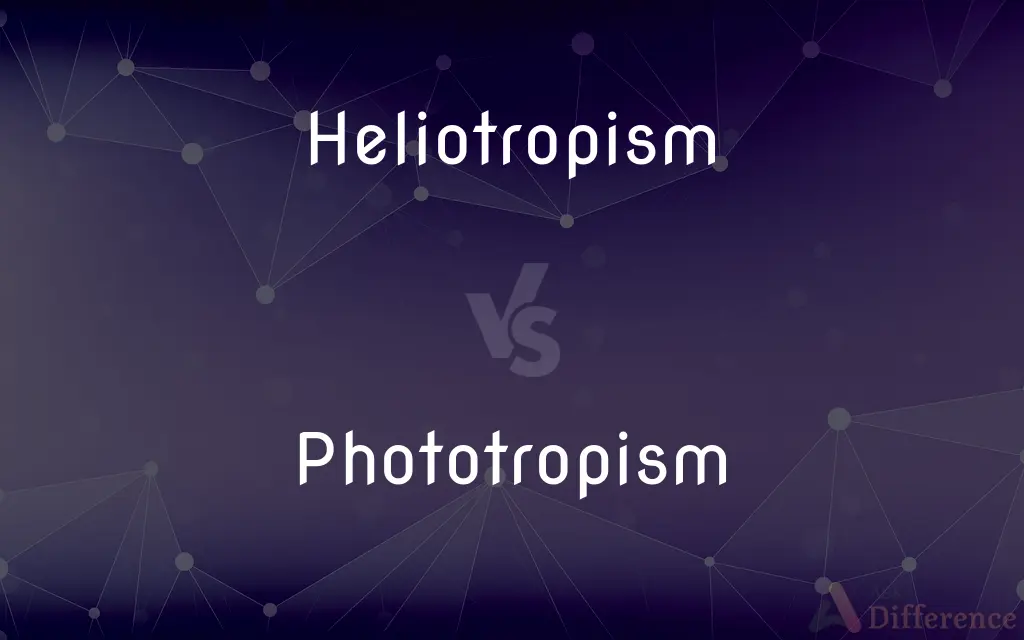Heliotropism vs. Phototropism — What's the Difference?
By Tayyaba Rehman & Urooj Arif — Updated on March 28, 2024
Heliotropism is the directional growth or movement of plants towards the sun, while phototropism refers to plant growth in response to light direction.

Difference Between Heliotropism and Phototropism
Table of Contents
ADVERTISEMENT
Key Differences
Heliotropism is a form of plant movement that specifically involves the plant or its parts, such as flowers or leaves, turning or bending towards the sun throughout the day to maximize sunlight exposure for photosynthesis. This movement can be observed in sunflowers, which face the sun as it moves across the sky. Phototropism, on the other hand, is a broader term that describes the growth of a plant in response to a light source, not limited to the sun, and can occur in any direction where light is perceived as being more intense.
While heliotropism is a dynamic process that can involve the movement of plant parts during the day and sometimes reorientation at night, phototropism results in a more permanent growth direction or curvature towards or away from a light source. Phototropism can be positive, with plants growing towards the light, as seen in most stems, or negative, with growth away from light, typically observed in some roots.
The mechanisms behind heliotropism and phototropism involve the plant’s perception of light and hormonal responses, particularly the movement of auxin, a plant hormone that promotes cell elongation. In heliotropism, the movement is often a result of differential growth or changes in cell turgor pressure that allow the plant to bend towards the sun. In phototropism, the uneven distribution of auxin on the shaded side of the plant leads to faster growth on that side, causing the plant to bend towards the light.
Heliotropism is especially significant in plants like the sunflower, where it maximizes the plant’s ability to capture sunlight for optimal photosynthesis. Phototropism, however, is crucial for the growth and survival of all plants, ensuring they grow in a direction that best allows them to access light for photosynthesis.
Both heliotropism and phototropism are vital adaptive strategies that enable plants to maximize their exposure to sunlight. However, while heliotropism is a more specific type of movement towards the sun, phototropism encompasses a broader range of growth responses to light, making it fundamental to plant development and survival.
ADVERTISEMENT
Comparison Chart
Definition
Movement of plants or their parts towards the sun.
Growth of plants in response to light direction.
Type of Response
Directional movement towards the sun.
Growth towards or away from a light source.
Examples
Sunflowers turning towards the sun.
Plant stems growing towards light; roots growing away from light.
Mechanism
Differential growth or cell turgor changes for sun tracking.
Uneven distribution of auxin leading to growth towards or away from light.
Significance
Maximizes sunlight exposure for photosynthesis in certain plants.
Ensures plants grow towards light for photosynthesis, essential for survival.
Specificity
Specifically related to the sun’s position.
Related to any light source, not specific to the sun.
Compare with Definitions
Heliotropism
Movement towards the sun.
The sunflower exhibits heliotropism by bending towards the sun throughout the day.
Phototropism
Growth in response to light direction.
Seedlings exhibit phototropism by bending towards a window.
Heliotropism
Maximizes photosynthesis.
Heliotropic movement ensures that the plant receives ample sunlight for energy.
Phototropism
Can be positive or negative.
The stems of most plants show positive phototropism, growing towards light, while some roots exhibit negative phototropism.
Heliotropism
Observed in specific plants.
Many desert plants show heliotropism to reduce water loss while maximizing light absorption.
Phototropism
Fundamental for plant development.
Phototropism helps plants in low-light environments grow towards light sources.
Heliotropism
Involves daily reorientation.
Some heliotropic plants reorient their flowers or leaves at night to anticipate the sunrise.
Phototropism
Involves growth hormones.
The uneven distribution of auxin causes plants to bend towards light in phototropic responses.
Heliotropism
Aids in optimal sunlight capture.
Heliotropism in sunflowers helps them to absorb maximum sunlight during their growth phase.
Phototropism
Ensures survival and growth.
Phototropism allows plants to optimize their exposure to light, crucial for their photosynthetic needs.
Heliotropism
Heliotropism, a form of tropism, is the diurnal or seasonal motion of plant parts (flowers or leaves) in response to the direction of the Sun. The habit of some plants to move in the direction of the Sun, a form of tropism, was already known by the Ancient Greeks.
Phototropism
Phototropism is the growth of an organism in response to a light stimulus. Phototropism is most often observed in plants, but can also occur in other organisms such as fungi.
Heliotropism
Growth or orientation of a sessile organism, especially a plant, toward or away from the light of the sun.
Phototropism
Growth or movement of a sessile organism toward or away from a source of light.
Heliotropism
The property of some plants of turning under the influence of light; either positively (towards the light) or negatively (away from the light)
Phototropism
(biology) The movement of a plant towards or away from light.
Heliotropism
The phenomenon of turning toward the light, seen in many leaves and flowers.
Phototropism
The tendency of growing plant organs to move or curve under the influence of light. In ordinary use the term is practically synonymous with heliotropism.
Heliotropism
An orienting response to the sun
Phototropism
Exhibiting movement in a direction toward (positive phototropism) or away from (negative phototropism) a source of light.
Phototropism
An orienting response to light
Common Curiosities
Can a plant exhibit both heliotropism and phototropism?
Yes, a plant can exhibit both behaviors, using heliotropism to follow the sun and phototropism to grow towards general light sources.
What causes phototropism in plants?
Phototropism is caused by the uneven distribution of auxin, a plant hormone, which leads to differential growth rates and bending towards a light source.
Why is heliotropism important for plants like sunflowers?
Heliotropism allows sunflowers to maximize sunlight capture for photosynthesis, enhancing their growth and development.
What is heliotropism?
Heliotropism is the movement or growth of a plant or its parts towards the sun to maximize sunlight exposure.
How do plants sense light for phototropism?
Plants have light-sensitive proteins that detect light, triggering hormonal responses that cause phototropic growth.
How does phototropism differ from heliotropism?
Phototropism refers to the growth of plants towards or away from a light source, not specifically the sun, while heliotropism is specifically sun-oriented.
How does heliotropism affect a plant's energy efficiency?
By optimizing the plant’s exposure to sunlight, heliotropism increases photosynthetic efficiency and energy production.
Are there any disadvantages to heliotropism?
In some cases, the energy expended in heliotropic movement might outweigh the photosynthetic benefits, especially if sunlight is not a limiting factor.
Is heliotropism common in all plants?
No, heliotropism is specific to certain plants that have adapted to track the sun, like sunflowers and some desert flora.
Can negative phototropism be beneficial for plants?
Yes, negative phototropism, such as roots growing away from light, helps plants anchor and access nutrients from the soil.
Do all parts of a plant respond to light in the same way?
No, different parts of a plant can exhibit positive or negative phototropism, depending on their function and growth needs.
How do growers use knowledge of phototropism in agriculture?
Growers can manipulate light exposure to influence plant growth and development, optimizing yield and plant health.
Can artificial lights trigger phototropism?
Yes, artificial lights can induce phototropic responses, making them useful in controlled growing environments like greenhouses.
What environmental conditions might influence phototropism?
Light intensity, direction, and duration can influence the extent and direction of phototropic responses in plants.
What research methods are used to study plant tropisms?
Researchers use controlled light environments, genetic analysis, and hormone studies to understand the mechanisms behind plant tropisms.
Share Your Discovery

Previous Comparison
Vanilla vs. Herb
Next Comparison
Fossil vs. PseudofossilAuthor Spotlight
Written by
Tayyaba RehmanTayyaba Rehman is a distinguished writer, currently serving as a primary contributor to askdifference.com. As a researcher in semantics and etymology, Tayyaba's passion for the complexity of languages and their distinctions has found a perfect home on the platform. Tayyaba delves into the intricacies of language, distinguishing between commonly confused words and phrases, thereby providing clarity for readers worldwide.
Co-written by
Urooj ArifUrooj is a skilled content writer at Ask Difference, known for her exceptional ability to simplify complex topics into engaging and informative content. With a passion for research and a flair for clear, concise writing, she consistently delivers articles that resonate with our diverse audience.
















































